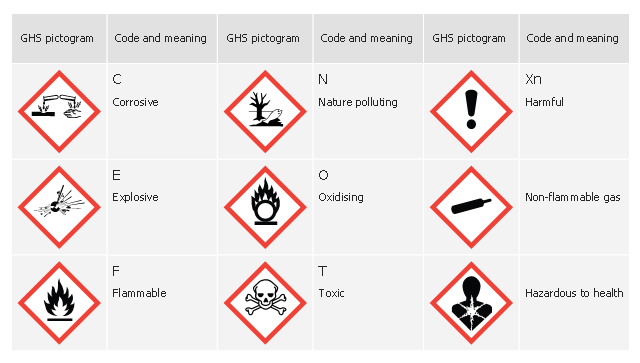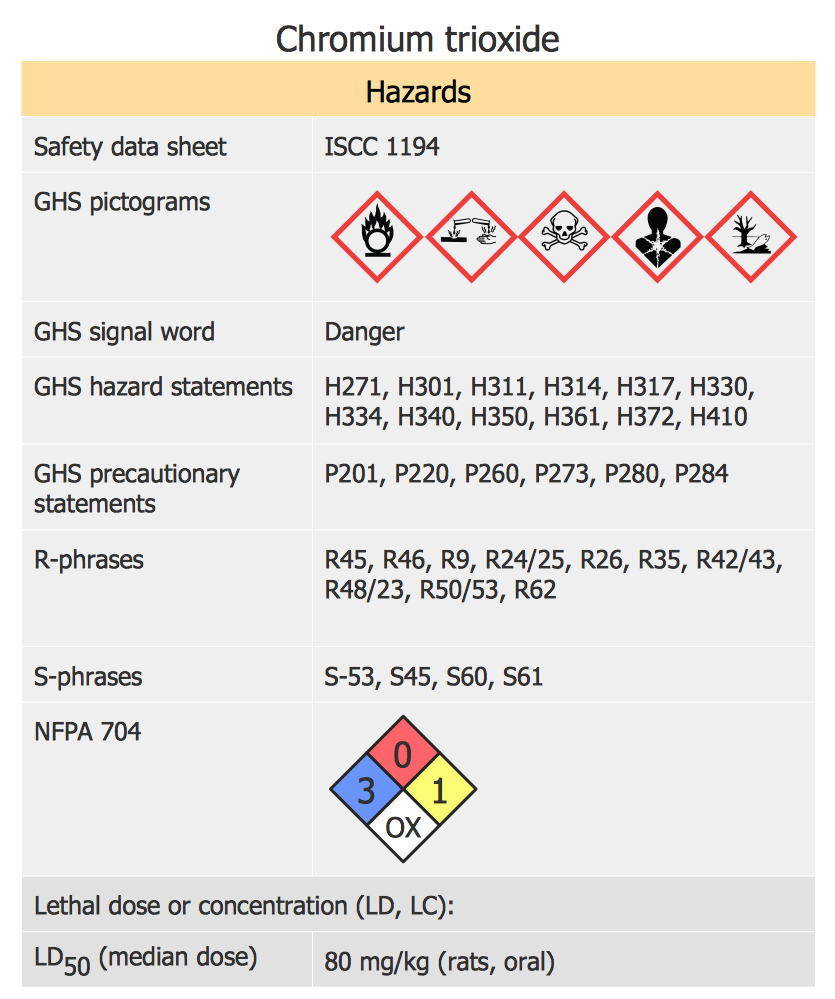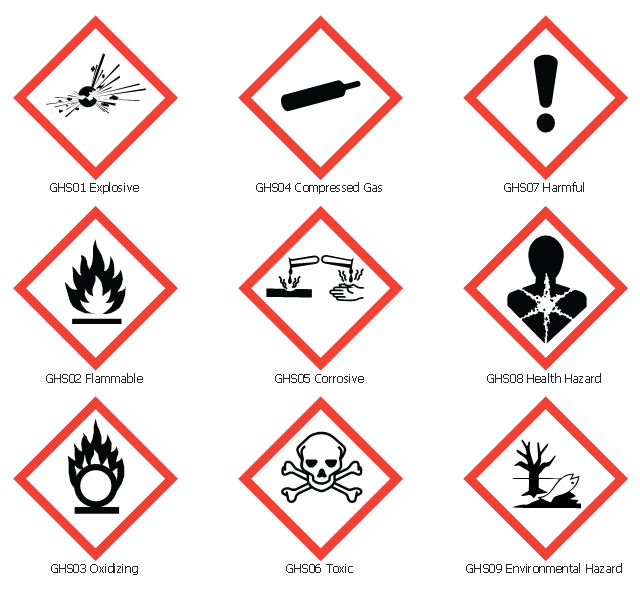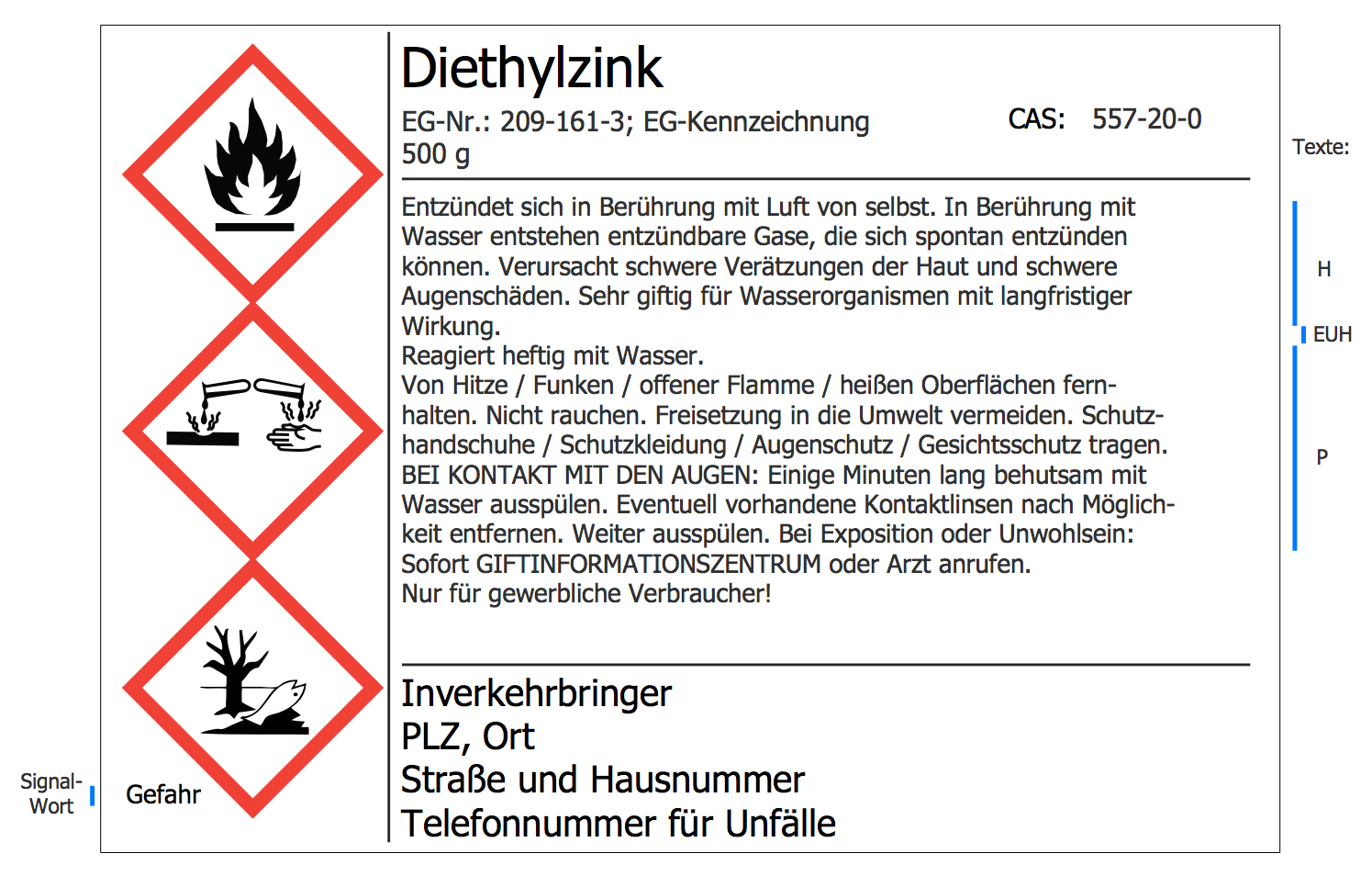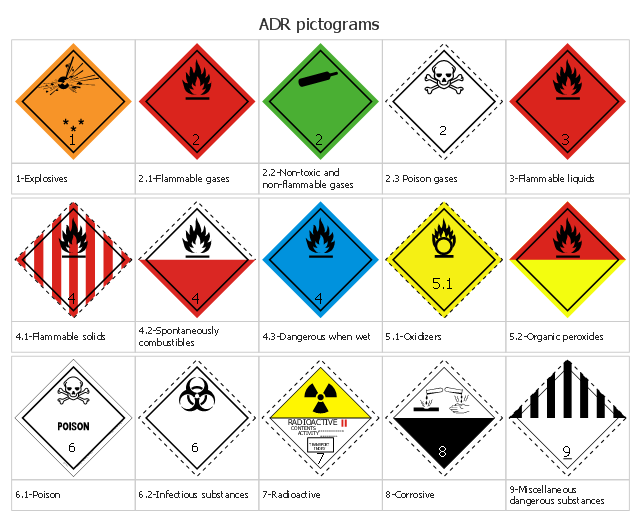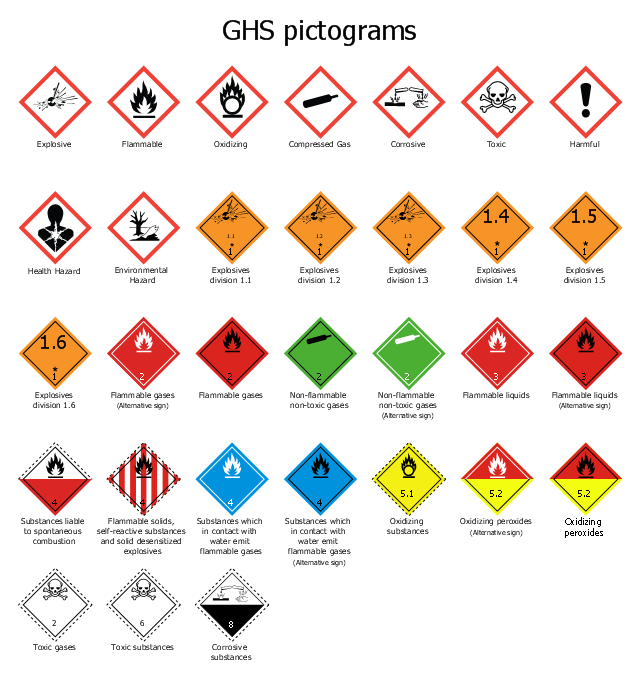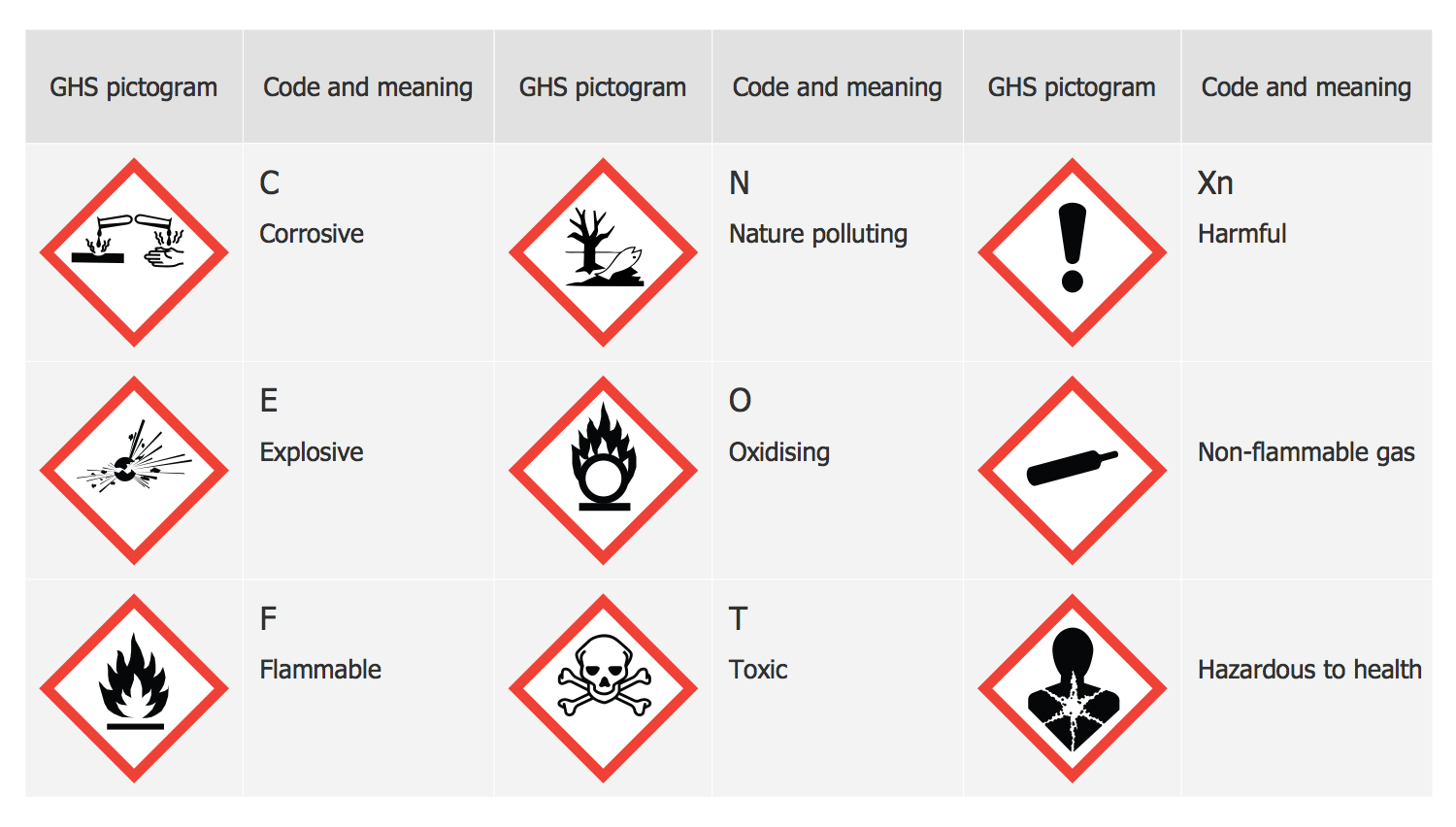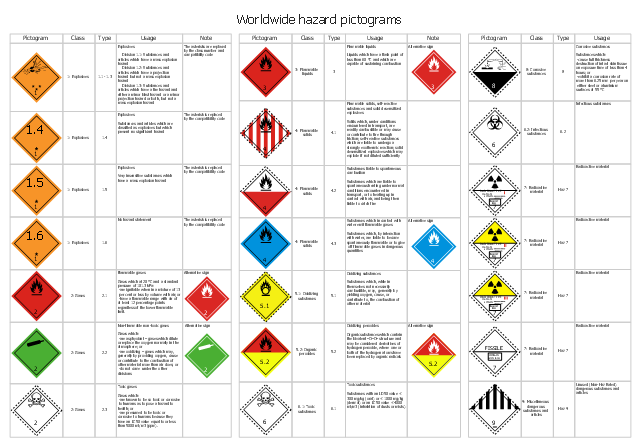This chemical safety infographic example shows the table of GHS hazard pictograms, their codes and meanings.
It was designed on the base of the table from the Wikimedia Commons article "GHS hazard symbols".
"Hazard symbols or warning symbols are recognisable symbols designed to warn about hazardous materials, locations, or objects, including electric currents, poisons, and radioactivity. The use of hazard symbols is often regulated by law and directed by standards organisations. Hazard symbols may appear with different colors, backgrounds, borders and supplemental information in order to specify the type of hazard. Warning symbols are used in many places in lieu of or addition to written warnings as they are quickly recognized (faster than reading a written warning) and more universally understood (the same symbol can be recognized as having the same meaning to speakers of different languages)." [Hazard symbol. Wikipedia]
The chemical safety infographic sample "GHS hazard symbols" was created using ConceptDraw PRO software extended with the GHS Hazard Pictograms solution from the Engineering area of ConceptDraw Solution Park.
It was designed on the base of the table from the Wikimedia Commons article "GHS hazard symbols".
"Hazard symbols or warning symbols are recognisable symbols designed to warn about hazardous materials, locations, or objects, including electric currents, poisons, and radioactivity. The use of hazard symbols is often regulated by law and directed by standards organisations. Hazard symbols may appear with different colors, backgrounds, borders and supplemental information in order to specify the type of hazard. Warning symbols are used in many places in lieu of or addition to written warnings as they are quickly recognized (faster than reading a written warning) and more universally understood (the same symbol can be recognized as having the same meaning to speakers of different languages)." [Hazard symbol. Wikipedia]
The chemical safety infographic sample "GHS hazard symbols" was created using ConceptDraw PRO software extended with the GHS Hazard Pictograms solution from the Engineering area of ConceptDraw Solution Park.
 GHS Hazard Pictograms
GHS Hazard Pictograms
GHS Hazard Pictograms solution contains the set of predesigned standard GHS pictograms, Hazardous symbols, and Hazard communication pictograms, approved and agreed by UN in Globally Harmonized System of Classification and Labelling of Chemicals (GHS). They can be used for quick and simple designing accurate and professional-looking infographics, diagrams, warning announcements, signboards, posters, precautionary declarations, regulatory documents, and for representing the main items of OSHA HAZCOM Standard.
HelpDesk
How To Design Regulatory Documents with use of Standard GHS Pictograms
A hazard pictogram is intended to provide information about the hazard that can cause a damage of a human health or the environment. GHS Hazard pictogram consists from a standard hazard symbol placed to the shape of a red diamond with a white background. GHS Hazard Pictograms solution from the ConceptDraw Solution Park includes the set of standardized GHS hazard pictograms. It can be used for creating safety infographics, warning announcements, labels and regulatory documentation containing the elements of OSHA HAZCOM Standard.The vector stencils library "GHS hazard pictograms" contains 9 chemical hazard symbols.
Use it in ConceptDraw PRO software to design your chemical safety infographics, labels of containers with hazardous materials, International Chemical Safety Cards (ICSC), manufacturers' Safety Data Sheets (SDS), and Material Safety Data Sheets (MSDS).
"Hazard pictograms form part of the international Globally Harmonized System of Classification and Labelling of Chemicals (GHS). Two sets of pictograms are included within the GHS: one for the labelling of containers and for workplace hazard warnings, and a second for use during the transport of dangerous goods. ...
Hazard pictograms are one of the key elements for the labelling of containers under the GHS, along with:
- an identification of the product;
- a signal word – either Danger or Warning – where necessary;
- hazard statements, indicating the nature and degree of the risks posed by the product;
- precautionary statements, indicating how the product should be handled to minimize risks to the user (as well as to other people and the general environment);
- the identity of the supplier (who might be a manufacturer or importer)." [GHS hazard pictograms. Wikipedia]
The chemical hazard symbols example "Design elements - GHS hazard pictograms" is included in the GHS Hazard Pictograms solution from the Engineering area of ConceptDraw Solution Park.
Use it in ConceptDraw PRO software to design your chemical safety infographics, labels of containers with hazardous materials, International Chemical Safety Cards (ICSC), manufacturers' Safety Data Sheets (SDS), and Material Safety Data Sheets (MSDS).
"Hazard pictograms form part of the international Globally Harmonized System of Classification and Labelling of Chemicals (GHS). Two sets of pictograms are included within the GHS: one for the labelling of containers and for workplace hazard warnings, and a second for use during the transport of dangerous goods. ...
Hazard pictograms are one of the key elements for the labelling of containers under the GHS, along with:
- an identification of the product;
- a signal word – either Danger or Warning – where necessary;
- hazard statements, indicating the nature and degree of the risks posed by the product;
- precautionary statements, indicating how the product should be handled to minimize risks to the user (as well as to other people and the general environment);
- the identity of the supplier (who might be a manufacturer or importer)." [GHS hazard pictograms. Wikipedia]
The chemical hazard symbols example "Design elements - GHS hazard pictograms" is included in the GHS Hazard Pictograms solution from the Engineering area of ConceptDraw Solution Park.
Hazard Chemical Sign
For each group of hazardous materials is designed its own hazard chemical sign, commonly used and approved at Globally Harmonized System of Classification and Labelling of Chemicals (GHS). The GHS Hazard Pictograms library offered by GHS Hazard Pictograms solution for ConceptDraw PRO diagramming software provides the predesigned vector objects for all standard GHS hazard pictograms: Explosive, Flammable, Oxidizing, Compressed Gas, Corrosive, Toxic, Harmful, Health Hazard, Environmental Hazard.This transportation safety infographic shows the ADR pictograms.
"ADR (formally, the European Agreement concerning the International Carriage of Dangerous Goods by Road (ADR)) is a 1957 United Nations treaty that governs transnational transport of hazardous materials. "ADR" is derived from the French name for the treaty: Accord européen relatif au transport international des marchandises Dangereuses par Route). ... The agreement itself is brief and simple, and its most important article is article 2. This article states that with the exception of certain exceptionally dangerous materials, hazardous materials may in general be transported internationally in wheeled vehicles, provided that two sets of conditions be met:
1. Annex A regulates the merchandise involved, notably their packaging and labels.
2. Annex B regulates the construction, equipment, and use of vehicles for the transport of hazardous materials." [ADR (treaty). Wikipedia]
The GHS transport hazard symbols infographic example "ADR pictograms" was designed using ConceptDraw PRO software extended with the Transport Hazard Pictograms solution from the Engineering area of ConceptDraw Solution Park.
"ADR (formally, the European Agreement concerning the International Carriage of Dangerous Goods by Road (ADR)) is a 1957 United Nations treaty that governs transnational transport of hazardous materials. "ADR" is derived from the French name for the treaty: Accord européen relatif au transport international des marchandises Dangereuses par Route). ... The agreement itself is brief and simple, and its most important article is article 2. This article states that with the exception of certain exceptionally dangerous materials, hazardous materials may in general be transported internationally in wheeled vehicles, provided that two sets of conditions be met:
1. Annex A regulates the merchandise involved, notably their packaging and labels.
2. Annex B regulates the construction, equipment, and use of vehicles for the transport of hazardous materials." [ADR (treaty). Wikipedia]
The GHS transport hazard symbols infographic example "ADR pictograms" was designed using ConceptDraw PRO software extended with the Transport Hazard Pictograms solution from the Engineering area of ConceptDraw Solution Park.
This chemical safety infographic shows the GHS hazard pictograms.
"Hazard pictograms are one of the key elements for the labelling of containers under the GHS, along with:
* an identification of the product;
* a signal word – either Danger or Warning – where necessary
* hazard statements, indicating the nature and degree of the risks posed by the product
* precautionary statements, indicating how the product should be handled to minimize risks to the user (as well as to other people and the general environment)
* the identity of the supplier (who might be a manufacturer or importer)" [GHS hazard pictograms. Wikipedia]
The transport hazard symbols infographic example "GHS pictograms" was designed using ConceptDraw PRO software extended with the Transport Hazard Pictograms solution from the Engineering area of ConceptDraw Solution Park.
"Hazard pictograms are one of the key elements for the labelling of containers under the GHS, along with:
* an identification of the product;
* a signal word – either Danger or Warning – where necessary
* hazard statements, indicating the nature and degree of the risks posed by the product
* precautionary statements, indicating how the product should be handled to minimize risks to the user (as well as to other people and the general environment)
* the identity of the supplier (who might be a manufacturer or importer)" [GHS hazard pictograms. Wikipedia]
The transport hazard symbols infographic example "GHS pictograms" was designed using ConceptDraw PRO software extended with the Transport Hazard Pictograms solution from the Engineering area of ConceptDraw Solution Park.
GHS Label Pictograms
Hazard pictograms are those which form a part of the international GHS which is a “Globally Harmonized System of Classification and Labelling of Chemicals. Two sets of pictograms are included within the GHS: one for the labelling of containers and for workplace hazard warnings, and a second for use during the transport of dangerous goods. Either one or the other is chosen, depending on the target audience, but the two are not used together.This transportation safety infographic shows the Worldwide hazard pictograms.
"Dangerous goods or hazardous goods are solids, liquids, or gases that can harm people, other living organisms, property, or the environment. They are often subject to chemical regulations. In the United States, United Kingdom and sometimes in Canada, dangerous goods are more commonly known as hazardous materials (abbreviated as HAZMAT or hazmat). Hazmat teams are personnel specially trained to handle dangerous goods, which include materials that are radioactive, flammable, explosive, corrosive, oxidizing, asphyxiating, biohazardous, toxic, pathogenic, or allergenic. Also included are physical conditions such as compressed gases and liquids or hot materials, including all goods containing such materials or chemicals, or may have other characteristics that render them hazardous in specific circumstances." [Dangerous goods. Wikipedia]
The GHS transport symbols infographic example "Worldwide hazard pictograms" was designed using ConceptDraw PRO software extended with the Transport Hazard Pictograms solution from the Engineering area of ConceptDraw Solution Park.
"Dangerous goods or hazardous goods are solids, liquids, or gases that can harm people, other living organisms, property, or the environment. They are often subject to chemical regulations. In the United States, United Kingdom and sometimes in Canada, dangerous goods are more commonly known as hazardous materials (abbreviated as HAZMAT or hazmat). Hazmat teams are personnel specially trained to handle dangerous goods, which include materials that are radioactive, flammable, explosive, corrosive, oxidizing, asphyxiating, biohazardous, toxic, pathogenic, or allergenic. Also included are physical conditions such as compressed gases and liquids or hot materials, including all goods containing such materials or chemicals, or may have other characteristics that render them hazardous in specific circumstances." [Dangerous goods. Wikipedia]
The GHS transport symbols infographic example "Worldwide hazard pictograms" was designed using ConceptDraw PRO software extended with the Transport Hazard Pictograms solution from the Engineering area of ConceptDraw Solution Park.
- GHS Hazard Pictograms | GHS hazard symbols | Design elements ...
- GHS Hazard Pictograms | Fire and emergency planning - Vector ...
- GHS Hazard Pictograms | GHS Label Pictograms | Diagrams Of ...
- Design elements - GHS hazard pictograms | GHS hazard symbols ...
- Chemistry Equation Symbols | Mathematical Diagrams | GHS ...
- GHS hazard symbols | GHS Hazard Pictograms | Design elements ...
- Symbol Of Hazardous Chemicals
- GHS hazard symbols | Design elements - GHS hazard pictograms ...
- Electrical Symbols — Electrical Circuits | Electrical circuits - Vector ...
- Design elements - GHS hazard pictograms | GHS HAZCOM Safety ...
